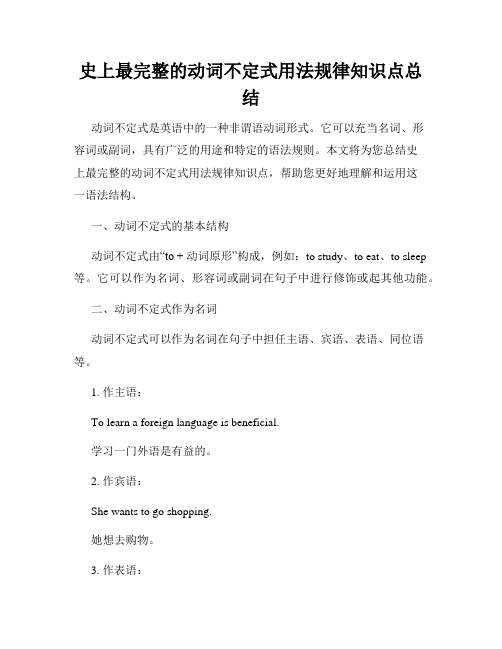最全英语动词不定式
中考英语---动词不定式用法归纳PPT课件

作宾语 动词不定式(短语)可以放在一些动词后面用作宾语,能以动词不定式作宾语的动词有:begin, start, want, forget, remember, show, learn, like, hate, love, ask等。 · I want to tell you a story. 我想给你讲个故事。 · They begin to work at eight every morning. 他们每天早晨8点开始工作。 · Don’t forget to lock the door.别忘了锁门。 · Would you like to go and have a picnic with us tomorrow?明天和我们起去野餐好吗?
本课结束
省“to”的不定式作宾语补足语:Let / make / have sb. do sth. Let the boy go out now. 让那个男孩出去。 The boy made the baby cry. 男孩弄哭了这个小孩。 see / watch / hear / notice / feel sb. do sth. I saw the students play basketball on the playground yesterday.昨天我看见学生们 在操场打篮球。 I often hear the girl sing in the next room. 我经常听到女孩在隔壁唱歌。 可省可不省的:help sb. (to)do sth. I often help my mother (to)do housework. 我经常帮妈妈做家务。
中考英语---动词不定式用法归纳 PPT课件
作主语
To be a doctor is hard. 做医生很难。 · To learn English well is not easy. 学好英 语不容易。 · To say is to believe.眼见为实。
初三英语语法知识汇总 动词不定式

动词不定式一、动词不定式的基本形式肯定式:to+动词原形否定式:not to+动词原形(to是不定式符号、标志,无意义,可以不翻译。
)二、动词不定式的特征动词不定式是一种非谓语动词形式,它没有人称和数的变化,但有时态和语态的变化,在句子中不能作谓语,但可以作除谓语之外的其它任何句子成分(主语、表语、宾语、宾语补足语、定语和状语);动词不定式具有名词、形容词和副词的特征,同时还保持动词的某些特点,即可以有自己的宾语和状语。
动词不定式和它的宾语和状语构成不定式短语。
三、动词不定式的用法1. 不定式作宾语能跟不定式作宾语的动词(及物动词)很多,构成vt.(及物动词)+to do sth. 结构。
常见的有:want, like, wish, hate, hope, prefer, try, ask, start, begin, decide, learn, choose, agree, expect , remember, forget等。
eg. He wanted to borrow my CD players. 他想借我的CD播放机。
His brother is learning to drive. 他弟弟正在学驾驶。
I hope to speak English well. 我希望讲好英语。
动词不定式作宾语其后又有补足语时,常用it作形式宾语,而把不定式后置。
eg. I find it difficult to learn physics. 我发现学习物理很难。
2. 不定式作宾语补足语动词不定式位于及物动词的宾语后,补充说明宾语,作补足语。
构成vt.+sb.+(not)to do sth. 结构。
常用带to的动词不定式作宾语补足语的动词结构有want sb.to do, ask sb.to do, tell sb.to do, order sb.to do, get sb.to do, wish sb.to do, allow sb.to do, invite sb.to do, teach sb.to do, encourage sb.to do, beg sb.to do等。
史上最完整的动词不定式用法规律知识点总结

史上最完整的动词不定式用法规律知识点总结动词不定式是英语中的一种非谓语动词形式。
它可以充当名词、形容词或副词,具有广泛的用途和特定的语法规则。
本文将为您总结史上最完整的动词不定式用法规律知识点,帮助您更好地理解和运用这一语法结构。
一、动词不定式的基本结构动词不定式由“to + 动词原形”构成,例如:to study、to eat、to sleep 等。
它可以作为名词、形容词或副词在句子中进行修饰或起其他功能。
二、动词不定式作为名词动词不定式可以作为名词在句子中担任主语、宾语、表语、同位语等。
1. 作主语:To learn a foreign language is beneficial.学习一门外语是有益的。
2. 作宾语:She wants to go shopping.她想去购物。
3. 作表语:His dream is to become a doctor.他的梦想是成为一名医生。
4. 作同位语:His goal, to win the championship, motivates him to practice every day.为了赢得冠军,他每天都在努力。
三、动词不定式作为形容词动词不定式可以作为形容词修饰名词,通常在名词之前。
1. 修饰名词:I have a book to read.我有一本要读的书。
2. 修饰人:She is the person to ask for help.她是可以求助的人。
四、动词不定式作为副词动词不定式可以作为副词修饰动词、形容词或副词,表示目的、结果、原因等。
1. 修饰动词:He bought a new computer to play games.他买了一台新电脑来玩游戏。
2. 修饰形容词:She is too tired to continue working.她太累了,无法继续工作。
3. 修饰副词:He speaks English fluently enough to communicate with foreigners.他的英语说得足够流利,可以与外国人交流。
不定式的六种形式及例句

不定式的六种形式及例句不定式是英语中最具重要意义的复合动词,它可以担当名词、形容词或副词,表示一个动作、状态或认识观念。
不定式可以用下列六种形式来表示:分解不定式: to + 动词原形1. 带 to 的不定式:以 to 开头,后面常跟动词原形,用来表示动作或行为,例如:He decided to go back home. 他决定回家去。
2. 动词不定式:动词不定式是没有 to 的不定式,用来表示动作,例如:He likes having a picnic. 他喜欢野餐。
3. 动名词:动名词的形式就是不定式的动词原形,表示状态或动作,也表示一种习惯的行为,例如:Climbing the mountain is difficult. 爬山很困难。
4. 现在分词:现在分词就是不定式的第三人称单数形式,表示动作,也表示现在的状态,例如:Seeing a movie is a good way to relax.看电影是放松自己的好方法。
5. 过去分词:过去分词就是不定式的完成式,表示一件已发生的动作,也表示状态,例如:Having finished the exam, he felt relieved.考试结束后,他感到如释重负。
6. 同位语从句:同位语从句不定式作表语,指代动作或状态,例如:His plan is to make a trip to France. 他的计划是去法国旅行。
不定式的用法比较复杂,但是它的用法比较常见,在句子中都能看到它的身影。
它不仅表示动作,还能表达一种状态和认识观念,在句子中能够体现精神,是语言表达的一种很有表现力的表达方式。
因此,大家要加强对不定式的学习,并熟练掌握六种形式,以求明确不定式的用法,更好的表达自己的想法和思想。
英语四六级史上最全最重要动词不定式大归类

动词不定式大全英语最全最重要的固定搭配,知道这些,英语成绩一路上涨!为孩子收藏!1、接不定式(不接动名词)作宾语的24个常用动词afford to do sth.负担得起做某事agreeto do sth.同意做某事arrangeto do sth.安排做某事askto do sth.要求做某事begto do sth.请求做某事careto do sth.想要做某事chooseto do sth.决定做某事decideto do sth.决定做某事demandto do sth.要求做某事determineto do sth.决心做某事expectto do sth.期待做某事fearto do sth.害怕做某事helpto do sth.帮助做某事hopeto do sth.希望做某事learnto do sth.学习做某事manageto do sth.设法做某事offerto do sth.主动提出做某事planto do sth.计划做某事prepareto do sth.准备做某事pretendto do sth.假装做某事promiseto do sth.答应做某事refuseto do sth.拒绝做某事wantto do sth.想要做某事wishto do sth.希望做某事2、接不定式作宾补的36个常用动词advise sb.to do sth.建议某人做某事allowsb.to do sth.允许某人做某事asksb.to do sth.请(叫)某人做某事bearsb.to do sth.忍受某人做某事begsb.to do sth.请求某人做某事causesb.to do sth.导致某人做某事commandsb.to do sth.命令某人做某事drivesb.to do sth.驱使某人做某事electsb.to do sth.选举某人做某事encouragesb.to do sth.鼓励某人做某事forbidsb.to do sth.禁止某人做某事forcesb.to do sth.强迫某人做某事getsb.to do sth.使(要)某人做某事hatesb.to do sth.讨厌某人做某事helpsb.to do sth.帮助某人做某事intendsb.to do sth.打算要某人做某事invitesb.to do sth.邀请某人做某事leavesb.to do sth.留下某人做某事likesb.to do sth.喜欢某人做某事meansb.to do sth.打算要某人做某事needsb.to do sth.需要某人做某事obligesb.to do sth.迫使某人做某事ordersb.to do sth.命令某人做某事permitsb.to do sth.允许某人做某事persuadesb.to do sth.说服某人做某事prefersb.to do sth.宁愿某人做某事requestsb.to do sth.要求某人做某事remindsb.to do sth.提醒某人做某事teachsb.to do sth.教某人做某事tellsb.to do sth.告诉某人做某事trainsb.to do sth.训练某人做某事wantsb.to do sth.想要某人做某事warnsb.to do sth.警告某人做某事wishsb.to do sth.希望某人做某事3、接动名词(不接不定式)作宾语的34个常用动词admit doing sth.承认做某事advisedoing sth.建议做某事allowdoing sth.允许做某事appreciatedoing sth.感激做某事avoiddoing sth.避免做某事considerdoing sth.考虑做某事delaydoing sth.推迟做某事denydoing sth.否认做某事discussdoing sth.讨论做某事dislikedoing sth.不喜欢做某事enjoydoing sth.喜爱做某事escapedoing sth.逃脱做某事excusedoing sth.原谅做某事fancydoing sth.设想做某事finishdoing sth.完成做某事forbiddoing sth.禁止做某事forgivedoing sth.原谅做某事giveup doing sth.放弃做某事imaginedoing sth.想象做某事keepdoing sth.保持做某事mentiondoing sth.提及做某事minddoing sth.介意做某事missdoing sth.错过做某事pardondoing sth.原谅做某事permitdoing sth.允许做某事practicedoing sth.练习做某事preventdoing sth.阻止做某事prohibitdoing sth.禁止做某事putoff doing sth.推迟做某事reportdoing sth.报告做某事riskdoing sth.冒险做某事stopdoing sth.停止做某事suggestdoing sth.建议做某事understanddoing sth.理解做某事4、接现在分词作宾补的20个常用动词bring sb.doing sth.引起某人做某事catchsb.doing sth.碰上(撞上)某人做某事discoversb.doing sth.发现某人做某事feelsb.doing sth.感觉某人做某事findsb.doing sth.碰上(撞上)某人做某事getsb.doing sth.使某人做某事havesb.doing sth.使某人做某事hearsb.doing sth.听见某人正在做某事keepsb.doing sth.使某人不停地做某事listento sb.doing sth.听某人正在做某事lookat sb.doing sth.看着某人做某事noticesb.doing sth.注意到某人做某事observesb.doing sth.观察某人做某事preventsb.doing sth.阻止某人做某事seesb.doing sth.看见某人做某事sendsb.doing sth.使某人(突然)做某事setsb.doing sth.使(引起)某人做某事startsb.doing sth.使某人开始做某事stopsb.doing sth.阻止某人做某事watchsb.doing sth.观察某人正在做某事5、接动词原形作宾补的11个常用动词feel sb.do sth.感觉某人做了某事havesb.do sth.使某人做某事hearsb.do sth.听见某人做某事letsb.do sth.让某人做某事listento sb.do sth.听着某人做某事lookat sb.do sth.看着某人做了某事makesb.do sth.使某人做某事noticesb.do sth.注意某人做了某事observesb.do sth.观察某人做了某事seesb.do sth.看见某人做了某事watchsb.do sth.观察某人做了某事6、接不定式或动名词作宾语意思相同的12个动词liketo do sth/like doing sth.喜欢做某事loveto do sth/love doing sth.喜欢做某事hateto do sth/hate doing sth.憎恨做某事preferto do sth/prefer doing sth.宁可做某事beginto do sth/begin doing sth.开始做某事continueto do sth/continue doing sth.继续做某事can’t bear to do sth/can’t bear doing sth.不能忍受做某事botherto do sth/bother doing sth.麻烦做某事intendto do sth/intend doing sth.打算做某事attemptto do sth/attempt doing sth.试图做某事ceaseto do sth/cease doing sth.停止做某事7、接不定式或动名词作宾语意思不同的7个动词(1)remember to do sth.记住要做某事rememberdoing sth.记住曾做过某事(2)forget to do sth.忘记要做某事forgetdoing sth.忘记曾做过某事(3)regret to do sth.后悔(遗憾)要做某事regretdoing sth.后悔(遗憾)曾做过某事(4)try to do sth.努力去做某事trydoing sth.尝试做某事(5)mean to do sth.打算做某事meandoing sth.意味着做某事(6)can’t help to do sth.不能帮助做某事can’t help doing sth.禁不住做某事(7)go on to do sth.做完某事后接着做另一事goon doing sth.继续做一直在做的事8、可接双宾语的38个常用动词(1)双宾语易位需借助介词to的常用动词awardsb.sth.=award sth.to sb.颁奖给某人bringsb.sth.=bring sth.to sb.把某带给某人handsb.sth.=hand sth.to sb.把某物递给某人lendsb.sth.=lend sth.to sb把某物借给ailsb.sth.=mail sth.to sb把某物寄给某人offersb.sth.=offer sth.to sb.将某物给某人owesb.sth.=owe sth.to sb.欠某人某物passsb.sth.=pass sth.to sb.把某物递给某人paysb.sth.=pay sth.to sb.付给某人钱postsb.sth.=post sth.to sb.把某物寄给某人readsb.sth.=read sth.to sb把某物读给某人听returnsb.sth.=return sth.to sb.把某物还给某人sendsb.sth.=send sth.to sb.把某物送给某人sellsb.sth.=sell sth.to sb.把某物卖给某人servesb.sth.=serve sth.to sb拿某物招待某人showsb.sth.=show sth.to sb把某物给某人看takesb.sth.=take sth.to sb把某物带给某人teachsb.sth.=teach sth.to sb.教某人某事tellsb.sth.=tell sth.to sb.告诉某人某事throwsb.sth.=throw sth.to sb把某物扔给某人writesb.sth.=write sth.to sb.给某人写某事(2)双宾语易位时需借助介词for的常用动词booksb.sth.=book sth.for sb.为某人预定某物buysb.sth.=buy sth.for sb.为某人买某物choosesb.sth.=choose sth.for sb.为某人选某物cooksb.sth.=cook sth.for sb.为某人煮某物drawsb.sth.=draw sth.for sb.为某人画某物fetchsb.sth.=fetch sth.for sb.为某人去取某物findsb.sth.=find sth.for sb.为某人找到某物fixsb.sth.=fix sth.for sb.为某人准备某物getsb.sth.=get sth.for sb.为某人拿来某物makesb.sth.=make sth.for sb.为某人做某物ordersb.sth.=order sth.for sb为某订购某物picksb.sth.=pick sth.for sb.为某人采摘某物preparesb.sth.=prepare sth.for sb.为某人准备某物savesb.sth.=save sth.for sb.为某人留某物singsb.sth.=sing sth.for sb.为某人唱歌sparesb.sth.=spare sth.for sb为某人让出某物stealsb.sth.=steal sth.for sb.为某人偷某物9、可用于“动词+sb+of sth”的8个常见动词accusesb.of sth.控告某人犯某事(罪),指责某人做某事cheatsb.fo sth.骗取某人某物curesb.of sth.治好某人的病,改掉某人的坏习惯informsb.of sth.通知某人某情况(事)remindsb.of sth.使某人想起某情况(事)ridsb.of sth.使某人摆脱某物robsb.of sth.抢劫某人的某东西warnsb.of sth.警告某人有某情况10、可用于“动词+sb+for doing sth”的8个常见动词blamesb.for doing sth.指责某人做某事criticizesb.for doing sth.批评某人做某事forgivesb.for doing sth.原谅某人做某事excusesb.for doing sth.原谅某人做某事pardonsb.for doing sth.原谅某人做某事punishsb.for doing sth.惩罚某人做某事scoldsb.for doing sth.指责(责备)某人做某事thanksb.for doing sth.感谢某人做某事11、可用于“动词+sb+into doing sth”的9个常见动词cheatsb.into doing sth.欺骗某人做某事tricksb.into doing sth.欺骗某人做某事foodsb.into doing sth.欺骗某人做某事forcesb.into doing sth.迫使某人做某事arguesb.into doing sth.说服某人做某事talksb.into doing sth.说服某人做某事terrifysb.into doing sth.威胁某人做某事frightensb.into doing sth.吓唬某人做某事persuadesb.into doing sth.说服某人做某事12、容易误用作及物动词的9个不及物词误:deal a problem正:deal with a problem处理问题误:depend sb.正:depend on sb.依靠(依赖)某人误:insist doing sth.正:insist on doing sth.坚持要做某事误:knock the door正:knock on[at]the door敲门误:operate sb.正:operate on sb.为某人做手术误:participate sth.正:participate in sth.参加某事误:refer sth.正:refer to sth.查阅(参考)某物误:rely sb./sth.正:rely on sb./sth.依靠(依赖)某人(某物)误:reply a letter正:reply to a letter回信13、容易误用作不及物动词的8个及物动词误:serve for sb.正:serve sb.为某人服务误:marry with sb.正:marry sb.与某人结婚误:discuss about sth.正:discuss sth.讨论某事误:mention about sth.正:mention sth.提到某事误:enter into a room 正:enter a room进入房间误:contact with sb.正:contact sb.与某人联系误:equal to sth.正:equal sth.等于某物误:ring to sb.正:ring sb.给某人打电话。
英语语法-动词不定式课件

d. saw
forget/remember doing sth.
stop/go on to do sth
stop/go on doing sth
The scientist stopped __ to me though he was
busy.
√
a. talking
b. to talk
c. to have talk
It’s +adj+of sb+to do sth. Eg:你能邀请我,你真是太善良了。 It’s very kind of you to invit me. 若形容词是描述人的性格、品质的,如 kind,good,nice,right,wrong,clever, careless,polite,foolish等,用of sb. Eg:你真聪明,解出了这道数学题。 It’s clever of you to work out the maths problem.
1. It takes you ten minutes to get there. 主语
2. I hope to see him soon.
宾语
3. His wish is to become an artist.
表语
4. People eat to live, but not live to eat. 状语
I wish to go with you.
need to do learn to do agree to do
plan to do decide to do refuse to do
begin to do start to do
try to do
forget to do remember to do like to do
初中英语动词不定式及动名词总结
初中英语动词不定式及动名词总结初中英语动词不定式及动名词总结(八年级)一、后跟动词不定式结构1.agree to do XXX同意做…2.decide to do XXX决定做…3.hope to do sth希望…4.need to do sth需要…5.offer to do sth主动…6.plan to do sth计划…7.can’t wait to do迫不及待…8.continue to do sth继续…9.try (one’s best) to do尽力…ed to do sth过去常常…11.feel lucky to do XXX做某事很幸运12.ask sb to do sth叫某人做13.want(sb)to do sth想要(某人)…XXX鼓励某人做…15.allow sb to do sth允许某人做…16.XXX提醒某人做…17.send sb to do sth派某人做…18.It’s +形+for sb +to do XXX做某事对或人来讲怎么样19.It XXX sb some time to do sth做某事破费或人多长工夫20.too+形+to do太…而不克不及…21.XXX do充足…能够做…22.不定式能够作表语My job\dream is to do23.不定式能够作定语a good way\place to do sth做某事的好方法24.不定式能够表目的To get good grades。
I must study hard2、后跟动名词方式1.consider doing sth考虑2.XXX喜爱3.XXX XXX做完某事4.mind doing sth介意5.keep doing sth一直keep on doing sth继续|坚持6.can’t。
doing sth停不下来7.can’t。
help doing sth不由得8.put off doing sth推迟9.give up XXX摒弃10.ba busy doing sth忙于11.have a good time doing XXX做某事很开心12.have XXX做某事很困那13.how \what about doing sth…怎么样14.XXX成功做15.XXX感谢做16.be XXX对做某事感乐趣be afraid of doing sth害怕be good at doing sth善于于XXX对做…自豪be used to doing sth惯于17.sb spend some time (in) doing sth18.XXX三.即可加to do又可加ing,但意思差别大XXX do XXX忘记要做某事(事情还未做)XXX遗忘做过某事(工作已做)XXX记得要做某事(事情还未做)XXX记得做过某事(事情已做)try to do XXX尽力去做某事XXX尝试做某事to do XXX停下了去做某事XXX停止做某事used to do XXX过去常常做某事be used to doing sth气于做某事四.后跟动词原型make sb do XXX使某人做某事let sb do XXX让某人做某事help sb (to) do sth帮助或人做某had better do XXX最好做某事五.便可跟原型,又可跟ingsee sb do XXX看见某人做了某事(事情已发生)XXX瞥见或人正在做某事(工作正在产生)hear sb do XXX听见或人…了(工作已产生)。
高中英语知识点归纳动词不定式的用法和结构
高中英语知识点归纳动词不定式的用法和结构动词不定式是英语中的一种非谓语动词形式,由动词原形加上to构成。
它可以充当名词、形容词或副词,具有时态、语态和语气的特点。
在高中英语学习中,动词不定式的用法和结构非常重要。
本文将对其进行归纳总结。
一、动词不定式作主语动词不定式可以充当句子的主语,常见的结构有:1. It + be + 形容词 + 不定式作主语例如:- It is important to learn a foreign language.学习一门外语很重要。
- It is necessary to finish the task before deadline.在截止日期之前完成任务是必要的。
2. 不定式结构作主语例如:- To travel around the world is my dream.环游世界是我的梦想。
- To study hard is the key to success.努力学习是成功的关键。
二、动词不定式作宾语动词不定式可以作及物动词的宾语,常见的结构有:1. 动词 + 不定式作宾语例如:- I want to go shopping this weekend.这个周末我想去购物。
- She decided to take a break and relax.她决定休息一下,放松一下。
2. 常见的动词有:agree, hope, promise, refuse, plan, learn, wish等。
三、动词不定式作补语动词不定式可以作宾语补足语,常见的结构有:1. 动词 + 宾语 + 不定式作补足语例如:- They made him work overtime.他们让他加班工作。
- We find it interesting to solve puzzles.我们发现解谜很有趣。
2. 情态动词 + 动词原形作补足语例如:- He can't afford to buy a new car.他买不起新车。
非谓语动词讲解史上最全
非谓语动词讲解史上最全非谓语动词是英语中的一种特殊动词形式,它们在句子中通常不具备时态和人称的变化。
非谓语动词包括不定式、动名词和现在分词。
一、不定式(Infinitive)不定式由to加动词原形构成,具有动词和名词的双重特征。
不定式在句子中可以作主语、宾语、表语、定语、状语等成分。
1. 作主语:To learn a foreign language is beneficial to your career.学习一门外语对你的事业有益。
2. 作宾语:I want to visit my grandparents this weekend.我想这周末去看望我的祖父母。
3. 作表语:His dream is to become a famous writer.他的梦想是成为一名著名的作家。
4. 作定语:She has many books to read.她有很多书要读。
5. 作状语:He came to help us.他来帮助我们。
二、动名词(Gerund)动名词由动词原形加-ing构成,具有动词和名词的双重特征。
动名词在句子中可以充当主语、宾语、表语、定语、状语等成分。
1. 作主语:Swimming is my favorite sport.游泳是我最喜欢的运动。
2. 作宾语:I enjoy reading novels in my free time.我喜欢在空闲时间读小说。
3. 作表语:Her hobby is singing.她的爱好是唱歌。
4. 作定语:The running water is clear.流动的水很清澈。
5. 作状语:She went shopping after finishing her homework.她在完成作业后去购物。
三、现在分词(Present Participle)现在分词由动词原形加-ing构成,具有动词和形容词的双重特征。
现在分词在句子中可以充当定语、表语、状语等成分。
动词不定式用法归纳全
动词不定式用法归纳全动词不定式这玩意儿,在英语学习里可算是个“常客”啦!今天咱们就来好好把它的用法捋一捋。
先来说说啥是动词不定式。
简单说,就是“to +动词原形”的形式,比如“to do”“to play”“to study”等等。
动词不定式在句子里的角色那可多了去了。
它能当主语,比如说“To learn English well is not easy” (学好英语不容易。
)这时候,它就像个带头的老大,引领着整个句子的意思。
当宾语的时候也不含糊,像“I want to go shopping” (我想去购物。
)“want”后面跟着的“to go shopping”就是宾语,表达了我心里想做的事儿。
还有当定语的时候,比如“There is nothing to worry about” (没什么可担心的。
)“to worry about”就是用来修饰“nothing”的。
当状语的时候呢,就像“He got up early to catch the first bus” (他早起是为了赶上第一班公交车。
)这里的“to catch the first bus”就是说明了他早起的目的。
再给您说个我教学时候的事儿。
有一次上课,我讲到动词不定式当宾语补足语的用法,就举了个例子“Tell him not to play in the street”(告诉他别在街上玩。
)然后我问同学们懂了没,结果有个小调皮眨着眼睛问我:“老师,那要是他非要在街上玩咋办?”全班哄堂大笑,我也乐了,然后耐心地跟他解释:“那可不行,这不仅危险,还不符合语法规则呀!”从那以后,这个知识点同学们记得特别牢。
咱们继续说,动词不定式还有一些固定的搭配和句型,像“It's +adj + for/of sb to do sth” (对某人来说做某事是……的)“tooto” (太……而不能……)等等。
比如说“It's kind of you to help me” (你帮助我真是太好了。
- 1、下载文档前请自行甄别文档内容的完整性,平台不提供额外的编辑、内容补充、找答案等附加服务。
- 2、"仅部分预览"的文档,不可在线预览部分如存在完整性等问题,可反馈申请退款(可完整预览的文档不适用该条件!)。
- 3、如文档侵犯您的权益,请联系客服反馈,我们会尽快为您处理(人工客服工作时间:9:00-18:30)。
动词不定式动词不定式是非谓语动词的一种形式。
其结构是“to+动词原形”,否定形式为“not+to+动词原形”。
动词不定式在句中不充当谓语,不受主语的限制,但有时态和语态的变化。
动词不定式是中考的必考点之一。
现结合最近几年的中考真题,全面梳理动词不定式的考点。
一、动词不定式做主语1. 动词不定式直接做主语。
如:To swim in the river is dangerous.在河里游泳是很危险的。
To ask the teacher for help is necessary.向老师寻求帮助是有必要的。
2.下列特殊句型中的动词不定式做真实主语。
▲“It is+形容词+for sb.to do sth.”意为“做某事对某人来说是……的”。
其中句中的形容词多为描述性的词语,不对人或物的品格进行评价,如difficult,easy,hard,important,dangerous,impossible等。
例1:It is imponant( ) people ( )good manners.A. for;to learnB. of;to learnC. for;learnD. of;learn解析:A。
句中的important是描述性形容词,因此用介词for,后接动词不定式做真实主语。
故选A。
▲“It is+形容词+of sb.to do sth.”意为“做某事对某人来说是……的”。
其中句中的形容词用于描述人的性格、品质,如kind,good,nice,right,wrong,clever,careless,polite,foolish等。
例2:—Let me help you carry the box,Granny—Thank you,Li Lei.It’s very nice( )you( ) me.A.of;to helpB. for;to helpC. of;helpingD. for;helpingB.解析:A。
句中的形容词nice是表示人的品质的形容词,因此后接介词of。
of后面的动词不定式做句子的真实主语。
故选A。
3. “It’s a/one’s+n.(task/duty/job)...+to do sth.”意为“做某事是……的任务/职责/工作”。
如:It’s my duty to save patients.治病救人是我的职责。
例3:—It’s our duty ( )our city clean and beautiful.—Yes.We should do something for it. A. to keep B. keep C. keeping解析:A。
考查“It’s one’s+名词+动词不定式”的用法。
故选A。
二、动词不定式做表语动词不定式做表语,一般用于be动词或seem等系表动词后面。
主语通常是wish,idea,works,task,job,aim等词。
如:My work is to clean the room every day.我的工作是每天打扫房间。
He seemed to have heard nothing.他似乎什么也没有听到。
三、动词不定式做宾语动词不定式做宾语是中考常考考点之一,具体用法分为两种情况:1. 一些动词必须接动词不定式做宾语,这类动词有want(想要),decide(决定),ask(问、寻求),learn(学习),tell(告诉),teach(教、讲授),hope(希望),plan(计划),refuse(拒绝),expect(期待、期望),afford(负担得起),warn(警告),invite(邀请)等。
例4:They decided( ) a bridge over the river. A. build B. to build C. building解析:B。
decide to do sth.意为“决定去做某事”。
例5:—Some children can’t afford( ) necessary stationary.—Let’s donate our pocket money to them.A. buyB. buyingC. to buyD. be bought解析:C。
afford to do sth.意为“有能力去做某事”。
故选C。
2.think,find,feel,make,believe等动词可用于“动词+it+形容词+to do sth.”结构。
在此句型中,it做形式宾语,而真正的宾语是后面的动词不定式。
例6:I found ()not very easy to() ride a bike.A. that;learnB. it;to learnC. that;to learn解析:B。
句意为:我发现学骑自行车不是很容易。
found后用it做形式宾语,真正的宾语是后面的动词不定式,故选B。
四、动词不定式做宾语补足语1. 后接带to的不定式做宾语补足语的动词有ask,want,tell,wish,would like,teach,invite,advise,allow,order,encourage,warn等。
例7:My friend invited me ( )the art club,and I accepted it with pleasure.A. joinB. to joinC. joinedD. joining解析:B。
invite sb.to do sth.意为“邀请某人做某事”。
故选B。
例8:Mr. Smith told his son() the football match because of the exam.A. not to watchB. to not watchC. not watchingD. doesn’t watch解析:A。
tell sb.not to do sth.意为“告诉某人不要做某事”。
故选A。
2.后接省略to的不定式做宾语补足语的动词有:一感(feel);二听(hear,listen to);三使(make,let,have);四看(see,watch,notice,look at)”。
但要注意的是:在被动语态结构中,应还原动词不定式符号to。
例9:what happens when you hear a strange noise at night,or find a big spider in thecorner of your bedroom?It often makes us( ) .A. jumpB. to jumpC. jumpingD. jumped解析:A。
make sb. do sth.意为“使某人做某事”。
例10:The girl was made() her brother’s clothes.A.to washB. washC. washing解析:A。
make sb.do sth.意为“使某人做某事”,用于被动语态时,省去的不定式符号to要加上,故选A。
五、动词不定式做定语1. 动词不定式做定语时位于被修饰词语之后,做后置定语。
例11:—We don’t have enough money for our field()trip.What shall we do?—The best way money is to sell newspapers.A. raise B. to raise C. raising解析:B。
答语句意为:筹集资金最好的方式是卖报纸。
to raise money做way的后置定语。
故选B。
2. 如果不定式动词与被修饰词之间有逻辑上的动宾关系,并且该动词是不及物动词,则需要加上适当的介词或副词使动宾关系成立。
例12:When you move somewhere new,the first thing for you is to find a place() .A. to liveB. living inC. to live in解析:C。
句意为:当你搬到一个新的地方时,首先要找一个住处。
句中用动词不定式做定语修饰名词,并和所修饰的名词存在动宾关系,排除B项;当动词不定式做定语和前面的名词存在动宾关系,动词若是不及物动词,需要在不定式后面加适当的介词。
故选C。
六、动词不定式做状语时可以表示目的、结果或原因等。
例13:when you leave,please turn off the lights() energy.A.saveB.to saveC.savingD.saved解析:B。
本题考查动词不定式做目的状语的用法。
句意为:当你离开的时候,请关上所有的灯,以便节约能源。
根据句意可知,关灯的目的是节约能源。
故选B。
例14:Mr. Li is a kind-hearted man.Though he is not rich,he always does everything ()he can the homeless children. A. to support B. support C. supporting D. supported解析:A。
本题考查动词不定式做目的状语的用法。
句意为:李先生是个好心人。
虽然他并不富有,但他总是愿意竭尽所能地帮助无家可归的孩子。
故选A。
七、特殊结构中的动词不定式可以和疑问词who,what,which,why,when,how,where等词连用,构成“疑问词+动词不定式”结构,在句中可以做主语、宾语和表语此结构通常位于下列动词之后:tell,teach,know,wonder,learn,show,find,out,ask,understand等。
例15:—So beautiful flowers!I can’t decide()for my mom.—For Mother’s Day,it can’t be better to take some carnation (康乃馨).A. when to chooseB. which to chooseC. how to choose解析:B。
考查含有特殊疑问词的动词不定式的用法。
句意为:如此美丽的花朵我不知道给妈妈买哪一种。
——在母亲节,最好送康乃馨。
when to choose“什么时候买”;which to choose“买哪一种”;how to choose“怎样选择”。
结合句意,选B。
例16:I really don’t know ()this question.It is too hard.A. which to answerB. how to answerC. what to answer解析:B。
